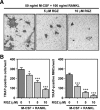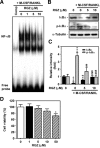The effects of rosiglitazone on osteoblastic differentiation, osteoclast formation and bone resorption
- PMID: 22286232
- PMCID: PMC3887713
- DOI: 10.1007/s10059-012-2240-z
The effects of rosiglitazone on osteoblastic differentiation, osteoclast formation and bone resorption
Abstract
Rosiglitazone has the potential to activate peroxisome proliferator-activated receptor-γ (PPARγ), which in turn can affect bone formation and resorption. However, the mechanisms by which rosiglitazone regulates osteoclastic orosteoblastic differentiation are not fully understood. This study examines how rosiglitazone affects osteoclast formation, bone resorption and osteoblast differentiation from mouse bone marrow. Rosiglitazone treatment not only inhibited the formation of tartrate-resistant acid phosphatase-positive cells, but also prevented pit formation by bone marrow cells in a dose- and time-dependent manner. Rosiglitazone also suppressed the receptor activator of nuclear factor (NF)-κB ligand (RANKL) receptor(RANK) expression but increased PPARγ2 expression in the cells. In addition, rosiglitazone diminished RANKL induced activation of NF-κB-DNA binding by blocking IκBαphosphorylation. Furthermore, it reduced collagen and osteocalcin levels to nearly zero and prevented mRNA expression of osteoblast-specific proteins including runtrelated transcription factor-2, osteocalcin, and type I collagen.However, mRNA levels of adipocyte-specific marker, aP2, were markedly increased in the cells co-incubated with rosiglitazone. These results suggest that PPARγ activation by rosiglitazone inhibits osteoblast differentiation with increased adipogenesis in bone marrow cells and also may prevent osteoclast formation and bone resorptionin the cells.
Figures








Similar articles
-
Substance P stimulates bone marrow stromal cell osteogenic activity, osteoclast differentiation, and resorption activity in vitro.Bone. 2009 Aug;45(2):309-20. doi: 10.1016/j.bone.2009.04.203. Epub 2009 Apr 18. Bone. 2009. PMID: 19379851 Free PMC article.
-
PPAR agonists stimulate adipogenesis at the expense of osteoblast differentiation while inhibiting osteoclast formation and activity.Cell Biochem Funct. 2014 Jun;32(4):368-77. doi: 10.1002/cbf.3025. Epub 2014 Feb 24. Cell Biochem Funct. 2014. PMID: 24615887
-
Poligoni Multiflori Radix enhances osteoblast formation and reduces osteoclast differentiation.Int J Mol Med. 2018 Jul;42(1):331-345. doi: 10.3892/ijmm.2018.3603. Epub 2018 Mar 30. Int J Mol Med. 2018. PMID: 29620250 Free PMC article.
-
Osteoblasts/stromal cells stimulate osteoclast activation through expression of osteoclast differentiation factor/RANKL but not macrophage colony-stimulating factor: receptor activator of NF-kappa B ligand.Bone. 1999 Nov;25(5):517-23. doi: 10.1016/s8756-3282(99)00210-0. Bone. 1999. PMID: 10574571
-
Bone Remodeling and the Role of TRAF3 in Osteoclastic Bone Resorption.Front Immunol. 2018 Sep 28;9:2263. doi: 10.3389/fimmu.2018.02263. eCollection 2018. Front Immunol. 2018. PMID: 30323820 Free PMC article. Review.
Cited by
-
Rosiglitazone suppresses RANKL-induced NFATc1 autoamplification by disrupting the physical interaction between NFATc1 and PPARγ.FEBS Open Bio. 2018 Sep 10;8(10):1584-1593. doi: 10.1002/2211-5463.12513. eCollection 2018 Oct. FEBS Open Bio. 2018. PMID: 30338210 Free PMC article.
-
Minireview: nuclear receptor regulation of osteoclast and bone remodeling.Mol Endocrinol. 2015 Feb;29(2):172-86. doi: 10.1210/me.2014-1316. Epub 2014 Dec 30. Mol Endocrinol. 2015. PMID: 25549044 Free PMC article. Review.
-
The multi-faceted role of retinoid X receptor in bone remodeling.Cell Mol Life Sci. 2017 Jun;74(12):2135-2149. doi: 10.1007/s00018-017-2458-4. Epub 2017 Jan 19. Cell Mol Life Sci. 2017. PMID: 28105491 Free PMC article. Review.
-
Oral anti-diabetic drugs and fracture risk, cut to the bone: safe or dangerous? A narrative review.Osteoporos Int. 2015 Aug;26(8):2073-89. doi: 10.1007/s00198-015-3123-0. Epub 2015 Apr 25. Osteoporos Int. 2015. PMID: 25910746 Review.
-
Molecular mechanism of thiazolidinedione-mediated inhibitory effects on osteoclastogenesis.PLoS One. 2014 Jul 17;9(7):e102706. doi: 10.1371/journal.pone.0102706. eCollection 2014. PLoS One. 2014. Retraction in: PLoS One. 2020 Feb 13;15(2):e0229392. doi: 10.1371/journal.pone.0229392. PMID: 25032991 Free PMC article. Retracted.
References
-
- Ali A.A., Weinstein R.S., Stewart S.A., Parfitt A.M., Manolagas S.C., Jilka R.L. Rosiglitazone causes bone loss in mice by suppressing osteoblast differentiation and bone formation. Endocrinology. 2005;146:1226–1235. - PubMed
-
- Baek W.Y., Kim J.E. Transcriptional regulation of bone formation. Front. Biosci. (Schol Ed.) 2011;3:126–135. - PubMed
-
- Benvenuti S., Cellai I., Luciani P., Deledda C., Baglioni S., Giuliani C., Saccardi R., Mazzanti B., Dal Pozzo. S., Mannucci E., et al. Rosiglitazone stimulates adipogenesis and decreases osteoblastogenesis in human mesenchymal stem cells. J. Endocrinol. Invest. 2007;30:RC26–30. - PubMed
-
- Bradford M.M. A rapid and sensitive method for the quantitation of microgram quantities of protein utilizing the principle of protein-dye binding. Anal. Biochem. 1976;72:248–254. - PubMed
Publication types
MeSH terms
Substances
LinkOut - more resources
Full Text Sources
Research Materials

